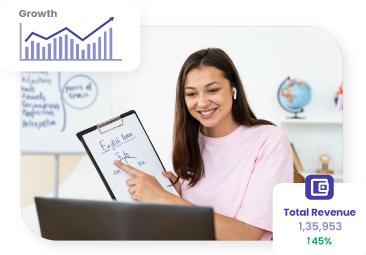Imagine walking by a stunning store display that stops you in your tracks, tempting you to step inside and explore. That’s exactly what a course landing page does for your online course — it captivates visitors and persuades them to take action. But what exactly is a course landing page, and why is it so crucial?
At its core, a course landing page is a dedicated web page crafted with one goal in mind: turning visitors into students or members. Unlike a generic website, this page focuses solely on showcasing your course’s value and inspiring enrollment.
Did you know that addressing buyer fears on landing pages can increase conversions by a remarkable 80%? This highlights the role of a good landing page in driving successful digital marketing campaigns.
A landing page can act as a bridge between attracting visitors and turning them into leads or customers. By understanding and effectively addressing the emotions of your potential customers, your landing page can significantly impact your bottom line.
Every effective course landing page includes three key ingredients:
- Visual Appeal: Clean, professional design grabs attention and builds trust.
- Value Proposition: Clear messaging that explains why your course is worth their investment.
- Social Proof: Testimonials, reviews, and success stories that reassure visitors your course delivers results.
As you begin designing your landing page, it’s essential to first consider who you’re speaking to. A stunning layout means nothing if it doesn’t resonate with your target audience. This brings us to the first crucial step: Defining your audience.
Defining Your Target Audience
Your audience is the cornerstone of your strategy, and the more you understand them, the more effectively you can create a great landing page. You can start with these basic steps:
Step 1: Know Who You’re Talking To
To get started, think about your ideal student. Ask yourself these questions:
- Who are they? What’s their age, profession, or location?
- What do they want? Are they looking to build a new skill, get a promotion, or start a side hustle?
- What are their challenges? What problems or frustrations can your course help them solve?
Visualize these people as real individuals and jot down their key traits. This will help you create content that speaks directly to their needs.
Step 2: Gather Insights From Real People
Once you’ve sketched out who your audience might be, go one step further and gather real feedback. Here’s how you can do it:
- Join Online Communities: Browse forums, Reddit threads, or Facebook groups where your audience hangs out. Pay attention to the questions they ask and the problems they share.
- Run Surveys or Polls: Create simple surveys using tools like Google Forms. Ask potential students about their biggest challenges and goals.
- Read Reviews: Check reviews of similar courses or products. What do people love? What do they wish was different?
By doing this, you’ll start to notice patterns and recurring themes—these are the pain points you need to address on your landing page.
Step 3: Meet Their Expectations
Now that you know your audience, it’s time to customize your content to match their needs. Here’s how:
- Use simple, clear language that avoids jargon.
- Focus on benefits they care about, like saving time or boosting income.
- Address their challenges directly with solutions your course provides.
For example, instead of saying, “Master advanced Excel techniques,” you might say, “Learn how to automate your spreadsheets and save hours every week.” This speaks to their frustration and offers a tangible benefit.
With your audience clearly defined, the next step is structuring your landing page for maximum impact. A well-designed structure ensures that every element works together to guide visitors toward enrolling.
Designing the Core Structure
A well-structured landing page is like a well-told story—it guides the visitor step by step until they’re ready to take action. Here’s how you can design one that works.
Step 1: Choose a Template That Converts
If you’re new to landing pages, using a pre-designed template is a smart choice. Check out Exly to explore various pre-designed templates. To choose one, you should Look for:
- Simplicity: A clear layout that avoids unnecessary distractions.
- Responsiveness: Templates that adapt to different screen sizes (critical for mobile users).
- Customizability: Options to align the page with your brand’s colors, fonts, and style.
Step 2: Create a Compelling Hero Section
The hero section is the first thing visitors see, so make it count. You can make it stand out in the following ways:
- Headline: A bold statement that highlights the main benefit. For example, “Master Photography in 30 Days.”
- Subheading: Add a supporting detail. For example, “Learn step-by-step techniques from a professional photographer.”
- CTA Button: Use clear, action-oriented language. Example, “Start Your Journey” or “Enroll Now.”
Step 3: Keep Branding Consistent
Picture this: a bright red label with white script pops into your mind, and you immediately think of Coca-Cola. That’s the power of a well-crafted brand identity. Coca-Cola’s consistent use of colors, logos, and messaging has made it iconic and instantly recognizable.
When building your course brand, you can apply the same principles. Start with a clear and unique logo that reflects the essence of your course. Pick a color palette that resonates with your audience.
For example:
- Calming blues for a meditation course
- Bold oranges for a high-energy fitness course
Pair this with fonts and visuals that align with your course’s tone and purpose. Finally, craft a message that speaks directly to your learners. Whether you aim to inspire, educate, or empower, let your messaging reflect that consistently across your materials. With these elements working together, your course brand will create a lasting impression, just like Coca-Cola does in its space.
A strong structure sets the stage, but it’s the content that persuades visitors to take action. Let’s jump into shaping compelling content.
Creating Persuasive Content
Content is where you convince visitors that your course is exactly what they need. Use these strategies to write content that converts.
Step 1: Write as if You’re Talking to a Friend
Address the reader directly and keep the tone conversational. For example:
- Instead of: “This course provides comprehensive marketing strategies.”
- Try: “You’ll learn practical marketing strategies you can apply right away.”
Step 2: Focus on Benefits Over Features
Features describe what your course includes, but benefits explain what the student will gain. Highlight benefits:
- Feature: “20 video lessons.”
- Benefit: “Master Instagram marketing in less than 2 weeks.”
Step 3: Use Bullet Points and Subheadings
Let’s agree that no one wants to read a wall of text. Break up your content with bullet points and strong subheadings that guide the reader through your page. For Example,
| What You’ll Gain From This Course:Strategies to grow your audience.Confidence to implement real-world marketing campaigns.Access to exclusive templates and resources. |
Step 4: Overcome Objections
Address common doubts with a FAQ or dedicated section. For Example,
| FAQ’s“What if I don’t have experience?”“How long will I have access to the course?”“Is there a money-back guarantee?” |
Once your content is in place, it’s time to reinforce your claims with visuals and social proof.
Utilizing Visuals and Public Trust
Did you know that adding images to your landing page can increase a person’s desire to read your content by a whopping 80%? That’s the impact of visuals—they grab attention, build trust, and make your page far more engaging.
Pair this with authentic testimonials, and you’ll get a winning combination. Testimonials provide proof that your course delivers results, while visuals create a connection with your audience. For instance, a well-designed infographic can break down complex ideas into easy-to-grasp visuals, and a heartfelt testimonial shows potential learners the value of your course.
Ready to make your page stand out? Here’s how to use visuals and testimonials effectively to convert visitors into students.
Step 1: Add Visuals That Inspire Action
Did you know that 38.6% of marketers rank video as the number 1 element for boosting landing page conversions? That’s because videos grab attention, spark interest, and give your audience a quick glimpse of what you’re offering.
A short, engaging course preview video can work wonders. Use it to showcase the value your course brings, highlight key benefits, and create excitement. Pair it with high-quality images or infographics to make your landing page vibrant and visually appealing. With the right visuals, you can turn casual visitors into eager learners!
The good news? You don’t need to be a video expert to create one that works for your course.
Here’s how you can create an effective course video:
- Start with Your Script
Write a conversational script that highlights the key benefits of your course. Focus on what your audience will learn, how it will help them, and why they should join. Keep it short—about 60–90 seconds is perfect. - Use Easy Tools
You can use user-friendly tools like Canva, InVideo, or even your phone’s camera to record and edit. Many of these platforms offer templates to make the process seamless. - Highlight What Makes Your Course Unique
Showcase key features, like interactive modules, downloadable resources, or community support. Use real footage from your course platform if possible—this builds authenticity.
Pair Video with Other Visuals
Add high-quality images or infographics to your landing page to support the video. For example:
- Use an infographic to explain the course structure or key benefits.
- Include irresistible snippets of course content
A bit of effort in creating a video and visuals can transform your landing page, making it more dynamic and irresistible to potential students.
Step 2: Show Real Results
Nothing builds trust like social proof. Include testimonials, case studies, or screenshots of positive feedback from previous students. If possible, showcase metrics- for example: “92% of students reported a promotion within six months.”
Simple, impactful quotes from past students. For example:
| “This course changed my career. I went from struggling with social media to landing five new high-paying clients in a month!” – Alisha |
Step 3: Include Instructor Bios
Let your audience know who’s teaching the course. A brief bio with a professional photo and relevant credentials can reassure visitors that they’re learning from an expert.
| Hi, I’m Alex Patel, a certified digital marketing expert with over 8 years of experience working with startups and Fortune 500 companies. I’ve managed campaigns generating millions in revenue and now help aspiring marketers like you succeed in the digital world.” |
Effective Call-to-Actions (CTAs) and Incentives
Landing Pages with clear CTAs convert 3x More. Your CTA is the gateway to conversion. It’s not just about placing a button—it’s about creating a compelling reason for your visitors to click. Here’s how to craft CTAs and incentives that truly work:
Step 1: Make Your CTAs Stand Out
Your CTA buttons should grab attention and guide visitors toward taking action. Here’s how to do it effectively:
- Placement: Ensure CTAs are visible in multiple spots:
- At the top of the page
- After showcasing key benefits or testimonials.
- At the bottom as a final push.
- Design: Use contrasting colors to make the button pop against the page background.
- Example: Claim Your Spot in the Digital Marketing Masterclass Now” (bright orange button on a white background)
Step 2: Use Clear, Actionable Language
Generic phrases like “Submit” or “Click Here” don’t inspire action. Instead, use language that tells visitors exactly what they’ll gain by clicking.
- Good Example:
- “Start Building Winning Ad Campaigns Today!”
- Bad Example:
- “Sign Up” (too vague and uninspiring).
Step 3: Offer Irresistible Incentives
Incentives make visitors feel they’re getting extra value for their investment. Sweeten the deal with offers to lure your learners:
- Discounts: Offer a limited-time discount for early sign-ups.
Example: “Enroll Now and Save 25%!”
- Free Bonuses: Include resources like templates, eBooks, or tools.
Example: “Sign up today and get our Ultimate Social Media Strategy Template free!”
- Guarantees: Provide a risk-free option, like a money-back guarantee.
Example: “If you don’t see results in 30 days, get a full refund—no questions asked!”
Example CTA Block:
| Headline: “Ready to Transform Your Marketing Skills?”CTA Button: “Join the Masterclass Now” Subtext: “Enroll before [date] to save 25% and receive exclusive bonuses.” |
When your CTAs and incentives are clear, engaging, and value-packed, you’ll motivate visitors to take that final step toward enrollment. Your CTA is the gateway to conversion. Make it impossible to miss.
Optimizing for Performance and Mobile Experience
Imagine this: You visit a website to learn about an exciting course, only for the page to take ages to load, or the text to look tiny and unclickable on your phone. Frustrating, right? That’s exactly why performance and mobile optimization are crucial. Slow load time, broken and poor mobile experiences can cost you conversions. In fact, statistics show that 53% of users abandon sites that take longer than 3 seconds to load.
Let’s explore the steps to ensure your landing page is fast, user-friendly, and optimized for every device.
Step 1: Ensure Mobile Responsiveness
Over 60% of website traffic now comes from mobile devices, which means most of your audience is viewing your page on their phones. If your landing page isn’t mobile-friendly, you’re risking a poor user experience—and losing potential learners.
To ensure your page looks and works perfectly on all screen sizes, here’s what to do:
- Use a Mobile-Responsive Template: As discussed earlier use pre-designed templates that adjust to mobile devices.
- Test Every Element: Ensure buttons are large enough to tap, images scale without distortion, and text is readable without zooming.
- Keep it Simple: Avoid overly complex layouts that might not translate well to smaller screens.
Test your page by viewing it on different devices (smartphone, tablet, etc.) and asking yourself, “Would I enjoy navigating this page?”
Step 2: Optimize Page Speed
Page speed is a silent killer—nothing frustrates visitors faster than a slow-loading page. Worse yet, it can quietly damage your conversion rates. To keep your audience engaged and your page performing at its best, follow these quick optimization tips:
- Compress Images: Use tools like TinyPNG to reduce image sizes without compromising quality.
- Minimize Code: Eliminate unnecessary code and plugins to streamline your page.
- Use a Content Delivery Network (CDN): CDNs like Cloudflare distribute your content across servers worldwide, speeding up load times.
Use tools like Google PageSpeed Insights to analyze your page’s performance and get actionable recommendations.
Step 3: Test and Refine
Optimization is an ongoing process. To keep your landing page performing at its peak, it’s essential to regularly test, evaluate, and make adjustments. Here’s how to do it:
- A/B Testing: Experiment with different headlines, CTA placements, or button colors to see what works best.
- Heatmaps: Tools like Hotjar show where users click and scroll, helping you identify what grabs attention and what’s ignored.
- Monitor Analytics: Track metrics like bounce rate, conversion rate, and time on the page using Google Analytics or a similar tool.
Common Mistakes to Avoid
A well-designed landing page can make all the difference in attracting students to your online course. It should clearly communicate value and encourage action however, a few common mistakes can hurt your chances of turning visitors into students. Here are some pitfalls to watch out for and how to avoid them.
- Lack of Visual Hierarchy
A poorly structured page with inconsistent fonts, colors, and layouts can confuse visitors and lead to lower conversions.
Avoid this mistake by:
- Using headings and subheadings to guide users through the content.
- Highlighting key information with bold text or icons.
- Cluttered Design
A cluttered landing page with too much text, multiple CTAs (calls-to-action), and distracting visuals can overwhelm visitors and dilute your message.
Avoid this mistake by:
- Keeping the layout clean and organized with ample white space.
- Using a single, clear call-to-action (e.g., “Enroll Now” or “Get Instant Access”).
- Ignoring SEO Optimization
If your landing page isn’t optimized for search engines, it may not attract organic traffic, limiting your reach and potential conversions.
Avoid this mistake by:
- Using relevant keywords in the page title, meta description, and headings.
- Ensuring the page follows on-page SEO best practices.
Conclusion
Now that we’ve walked through the steps, it’s time to bring your landing page to life. Your online course deserves more than just a page that grabs attention—it needs one that captures hearts. By truly understanding your audience and offering content that resonates with their needs and desires, you’ll create an experience that speaks directly to them.
Add a design that effortlessly guides visitors toward taking action, and you’ve got the perfect formula for success. But here’s the key: the best landing pages aren’t set-and-forget projects. They’re created, tested, and refined over time. With regular insights and feedback, you’ll keep your page fresh, relevant, and continuously engaging for your learners at every step of their journey.
Why wait? With Exly, you can build a landing page that not only showcases your expertise but also drives meaningful engagement.
Exly offers:
- Pre-designed templates
- Easy-to-use interface and
- All-in-one dashboard
Start building a high-converting landing page today and watch your online course reach new heights!
Get started for FREE!





